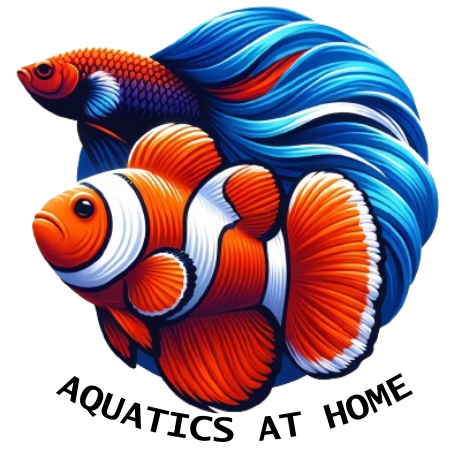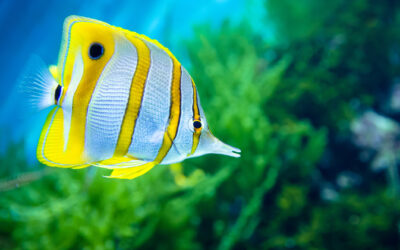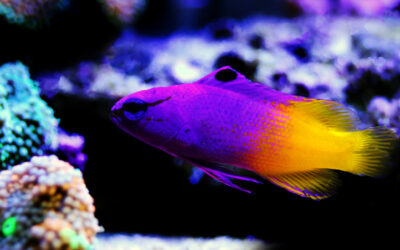Setting up a saltwater aquarium for a beginner can be so much fun! If you are super new to the hobby, I hope you are taking your time to plan – trust me, it’ll save you a ton of cash really quickly. With proper planning, you will avoid unnecessary challenges (and probably some deaths) in your tank’s soft launch phase (you know, before you start posting all your tank pics to Reddit for clout).
If you cycle the tank properly and grow your community slowly, you will likely be better off in the long term. Bigger tanks and more hiding places can allow for more fish, but you always want to make sure they get along with everyone else in the tank. This means your corals, anemones, clean-up crew, and fish.
I had a sneaky red-leg hermit (who I named Jack) that got too big and ended up killing one of my smaller community fish – a completely avoidable problem if I had simply rehomed Jack to a tank with bigger fish. Plan around growth, establishing territories, and potential movement. If you plan conservatively, you will have a much smoother ramp into success.
Your tank can be a utopia, and it can also be an underwater Thunderdome if you aren’t careful! I personally want your fish to live long, happy lives – they are capable of living much longer than most think.
So on to the good stuff: here are the best beginner fish for saltwater tanks, ideal for those just dipping their toes into the world of saltwater fishkeeping.
Clownfish
Clownfish, also known as anemonefish (or… and please don’t call them this… nemos), are undoubtedly one of the most popular types of saltwater aquarium fish. Thanks to their iconic appearance in the movie Finding Nemo, they have captured the hearts of many. Clownfish are a member of the damselfish family and are found mainly in the warm waters of the Pacific and Indian Oceans.
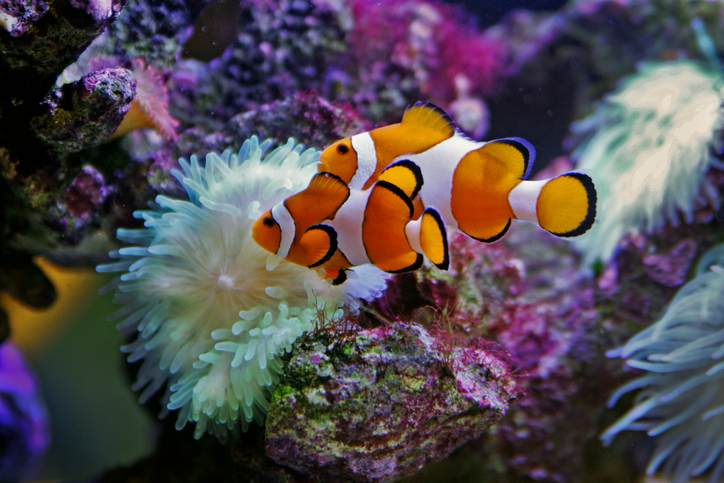
My first clown was named Jeffrey – that lil’ fish lived well over 10 years, and he knew me! They would come to the front of the tank (that’s right, y’all – Jeffrey was a boy but later grew up into a female! Clownfish do that – pretty crazy, right?)
These fish are pretty easy to care for and are generally hardy, making them an excellent choice for beginners. They are known for their bright colors, which vary from species to species. Some of the most popular species include the orange and white Ocellaris clownfish and the black and white Percula clownfish.
Clownfish are omnivores, so basically, they eat both meat and plant-based foods. In the wild, they primarily feed on algae, plankton, and small crustaceans. In captivity, they will eat most kinds of food, including flakes, pellets, and frozen foods.
These fish grow to about 3-4 inches and prefer a temperature between 75°F and 82°F. They also require plenty of hiding places in the aquarium, as well as a good protein skimmer (or lots of water changes), as they produce a lot of waste. It is super important to keep the water quality high, as clownfish are susceptible to diseases such as marine ich and velvet.
Clownfish are known for their symbiotic relationship with sea anemones. In the wild, they live among the tentacles of these creatures, which provide them with protection from predators. In return, the clownfish helps to remove parasites and debris from the anemone’s tentacles.
While clownfish are relatively easy to care for, they do require a specific environment to thrive. This includes a well-established aquarium with live rock and a sand substrate. It is also important to research the specific species of clownfish you plan to keep, as some have unique requirements.
Hop into your LFS, and you will quickly learn that ocellaris and false percula are the common “Nemo” types you are most familiar with, but breeding clowns is actually pretty easy, and people have selectively bred traits to produce beautiful variations. The price of clownfish varies wildly, but most clowns will love you just the same regardless of their looks (and they will probably attack your hand if you put it in the tank… out of love!).
Without a doubt, clownfish are a popular and fascinating addition to any saltwater aquarium. Their bright colors, unique behavior, and easy-to-care-for nature make them an excellent choice for both beginners and experienced hobbyists alike.
Damselfish
Damselfish, also known as damsels, are small, hardy, and colorful fish that are ideal for a beginner’s saltwater aquarium. They come in a variety of striking colors and patterns, making them an excellent addition to any reef tank.

Their feeding requirements are relatively simple, and they can be fed with flake or pellet food. However, overfeeding can lead to health issues, such as obesity and swim bladder problems. It is recommended to feed them small amounts several times a day rather than one large feeding.
Damselfish are known for their territorial behavior, and it is important to provide them with enough space in the aquarium. You will hear fish store pros saying, “Damsels are jerks,”… but they aren’t always jerks. Give them plenty of hiding places and some space to call their own, and you might avoid some of their aggression.
Damsels can be kept in pairs or small groups but introduced at the same time to avoid that aggression. While damselfish are generally hardy and easy to care for, they can still be susceptible to diseases and parasites. It is important to monitor their behavior and appearance regularly and to quarantine new fish before introducing them to the main tank, especially if your tank is established. You don’t want to nuke your tank… so take your time.
In addition to their colorful appearance, damselfish are also known for their interesting behaviors. They are active swimmers and can often be seen darting around the tank. Some species of damselfish are also known to clean other fish by nibbling on parasites and dead skin.
Overall, damselfish are a great choice for beginners looking to add some color and activity to their saltwater aquarium. With proper care and attention, they can live for several years and provide endless entertainment. Damsels were my first fish! I had several, and they got along just fine. I highly recommend these varied and colorful little ones as a first fish.
Pseudochromis
Pseudochromis, commonly known as dottybacks, is a fantastic choice for beginners venturing into saltwater aquariums. Their vivid hues and slender bodies make them a visually appealing addition to any marine setup.

These fish are generally unfussy eaters and can subsist on a diet of flake, pellet, or frozen foods. Yet, it is essential to prevent overfeeding as this can cause a range of health issues, such as obesity and digestive troubles. Feeding them in small portions several times a day, as opposed to a single large feeding, is the recommended approach.
While they are pretty community safe, you should definitely consider the size of your other community fish when introducing these ones. I had a beautiful purple dottyback in a smaller tank that I, unfortunately, had to return because I was so afraid of the other inhabitants. Remember, a scared fish is going to live a much shorter life than a happy one – watch carefully and do right by them, please!
Despite my story, Pseudochromis are more commonly known for their territorial nature. Providing them with a spacious tank is crucial to prevent aggressive behavior. If kept in pairs or groups, it’s advised to introduce them to the tank simultaneously to minimize confrontations. Including live rock formations and other tank, accessories can help establish boundaries and hiding spots, mitigating territorial disputes. Again, the hiding spots are so crucial.
While Pseudochromis are typically robust and low maintenance, they are not immune to diseases and parasites. Regular observation of their behavior and physical state is key to maintaining their health. Any new fish should be quarantined and carefully observed before being introduced into the main tank to prevent the spread of disease.
Dottybacks exhibit unique behaviors that make them a captivating presence in any aquarium. They are agile swimmers and can be observed weaving in and out of rockwork. Some species of Pseudochromis are also known to mimic the appearance of other fish, a behavior that adds an extra layer of intrigue to their presence. I did end up getting a bigger dottyback that would flash purple across the tank, and it was a sight to behold!
All in all, Pseudochromis make a vibrant and lively addition to beginner saltwater aquariums. They are relatively easy to care for and can have a lifespan of several years with the right care and attention. Their intriguing behaviors and striking colors offer endless fascination and a dash of drama to any marine environment.
Gobies
Gobies are small, charismatic fish with long bodies and large eyes, making them a great addition to any tank. There are many species of gobies, each with their unique personalities and appearance.
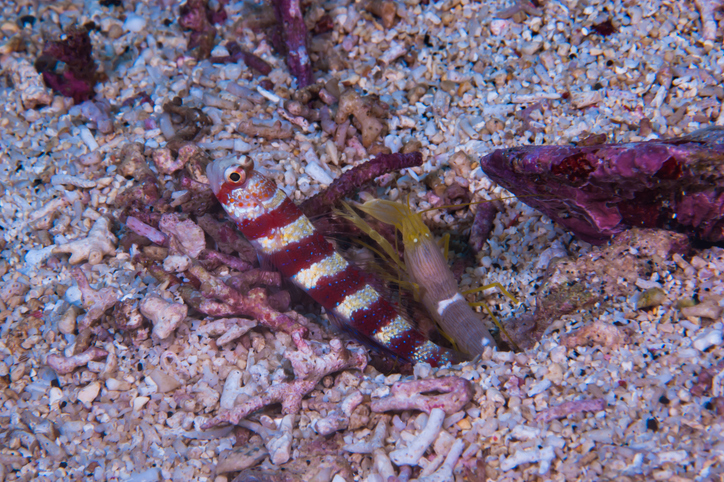
Gobies are generally non-aggressive and are compatible with most other species of saltwater fish. They grow to around 2-4 inches and prefer temperatures between 75°F and 82°F. In the wild, gobies feed on small invertebrates, so they prefer live or frozen foods over dry foods.
One of the most popular species of gobies is the neon goby, which is known for its bright blue and yellow coloration. These fish are native to the Indo-Pacific region and are often found in coral reefs. Neon gobies are often used in aquariums to help control parasites on other fish, as they are known to eat the small crustaceans that can cause problems for other species. Neon gobies are great for small tanks as solo additions. One is enough, and they can do quite well in tanks as small as 10 gallons, provided the tank isn’t overstocked.
Another interesting species of goby is the shrimp goby, which has a symbiotic relationship with pistol shrimp. The shrimp will dig a hole in the sand, and the goby acts as a lookout, warning the shrimp of any potential predators. In return, the shrimp provides the goby with a safe place to live.
Gobies are also known for their unique spawning habits. Many species of gobies lay their eggs in burrows or crevices, where the male fish guards them until they hatch. Some species of gobies are even known to change their gender depending on the needs of the group. For example, if the male fish dies, the largest female will change into a male to take its place.
Overall, gobies are a fascinating and unique addition to any saltwater aquarium. With their interesting behaviors and striking appearance, they are sure to be a favorite among fish enthusiasts.
Bicolor Blennies
Blennies are a fascinating species of fish that have captured the hearts of many aquarium enthusiasts. These small, colorful fish are a great choice for beginner saltwater aquariums, as they are hardy, easy to care for, and come in a variety of vibrant colors and patterns.
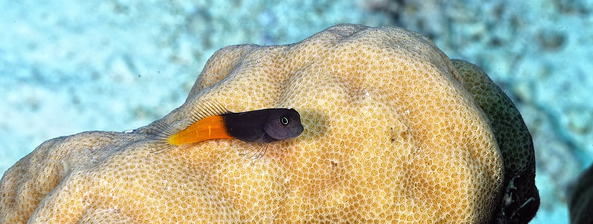
Blennies are known for their unique appearance, which includes a long, slender body, a blunt head, and a single dorsal fin that runs the length of their body. They also have large eyes that give them a curious and endearing expression.
One of the most interesting things about blennies is their behavior. They are generally bottom-feeders, so they prefer a sand substrate in which to burrow. This behavior is not only fascinating to watch, but it also helps to keep the sand clean and well-oxygenated.
Blennies can grow to around 3-4 inches and prefer temperatures between 75°F and 82°F. They are also relatively peaceful fish, making them a great addition to community aquariums.
In terms of diet, blennies are not picky eaters. They can be fed on a vegetarian diet as they are herbivores. However, it’s important to note that they have small mouths, so their food should be appropriately sized.
Overall, blennies are a wonderful choice for anyone looking to add some color and personality to their saltwater aquarium. With their unique appearance and fascinating behavior, they are sure to be a captivating addition to any tank.
Twospot Hawkfish
Hawkfish are another great choice for beginner saltwater aquarists. They have a unique appearance, with large eyes and spiny fins, and come in different colors and patterns.
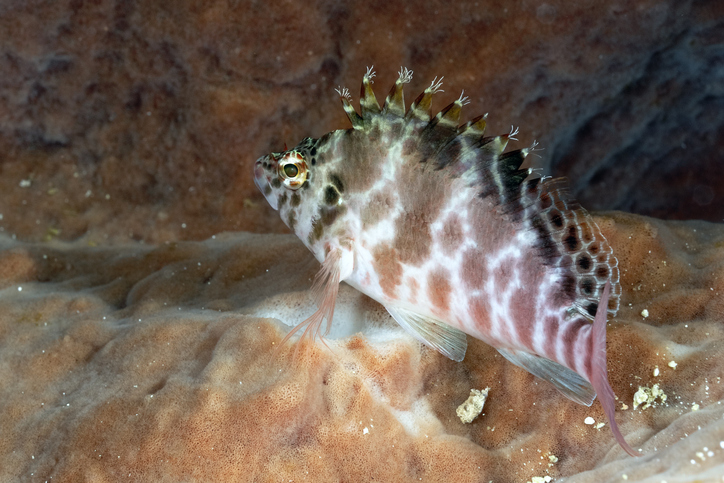
Hawkfish grow to around 4 inches and prefer temperatures between 75°F and 82°F. They are hardy and easy to feed, accepting most foods. However, they need plenty of hiding spaces in the aquarium as they can be somewhat aggressive with their tank mates. Also, if you are planning on having coral in your tank… continue with caution, as these fish are known to occasionally go after corals.
If you are considering adding a hawkfish to your saltwater aquarium, it is important to note that they are primarily carnivorous and should be fed a diet of meaty foods such as shrimp, krill, and small pieces of fish. They also enjoy live foods such as brine shrimp and small crabs.
It is recommended to provide plenty of rockwork and caves in the aquarium to give your hawkfish a place to hide and establish their territory. They are known to perch on rocks and coral, using their pectoral fins to stabilize themselves.
One interesting fact about hawkfish is that they have the ability to change color to blend in with their surroundings. This is known as “chromatic adaptation” and helps them to avoid predators in the wild.
Overall, hawkfish are a great addition to a saltwater aquarium for their unique appearance, hardiness, and interesting behaviors. With proper care and a well-established aquarium, they can thrive and provide enjoyment for years to come.
Pajama Cardinalfish
Cardinalfish are a fascinating species of fish that are a great choice for beginner marine aquarists. They are a type of fish that belong to the family Apogonidae and are known for their peaceful nature and attractive appearance.
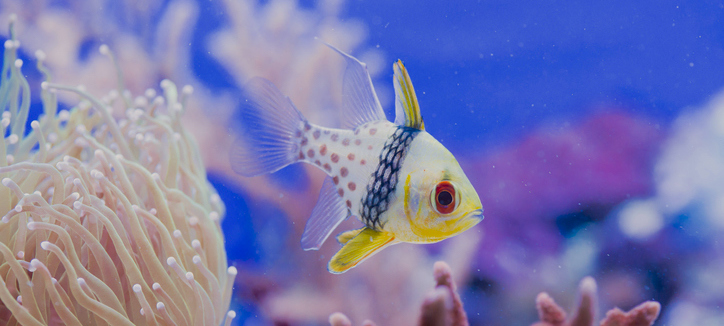
Cardinalfish are found in different colors, ranging from bright reds to yellows and blues. They have a unique body shape, with a long, slender body and a large head. Their calm temperament and ease of care make them a popular choice among aquarists. I always thought of my pajama cardinalfish as saltwater tetras – they are kind of similar in their behavior.
These small, shoaling fish grow to around 3 inches in length and prefer temperatures between 75°F and 82°F. They are a hardy species and can adapt to a range of water conditions, making them easy to care for.
Cardinalfish are a social species and prefer to be kept in groups. They are known for their schooling nature, which makes them a great addition to any aquarium. When kept in groups, they will swim together in a synchronized manner, creating a beautiful display.
In the wild, Cardinalfish feed on a variety of small crustaceans and other invertebrates. In the aquarium, they can be fed on flakes, pellets, or frozen foods. It is important to provide them with a varied diet to ensure they receive all the necessary nutrients.
Overall, Cardinalfish is a great choice for beginner marine aquarists. They are easy to care for, peaceful, and attractive species that will add a pop of color and personality to any aquarium.
Wrasses – Particularly, the Six Line Wrasse
Wrasses are a diverse family of fish, with over 600 species found in tropical and subtropical waters around the world. They are known for their striking and vibrant colors, active personalities, and interesting behaviors.

One of the most striking things about wrasses is their coloration. Many species have bright, vivid hues that range from electric blues and greens to deep purples and oranges. Some even have intricate patterns and markings that make them look like living works of art. I absolutely love the six-line wrasse – this is a must-have for starter tanks. They eat pests and sleep in cute little mucus nests (looks like a cocoon). Also, they are super colorful!
But wrasses are more than just pretty fish. They are also known for their playful behavior, which can make them a joy to watch in the aquarium. Some species, like the bird wrasse, are particularly acrobatic and will jump and dart around the tank with impressive speed and agility.
When it comes to caring for wrasses, there are a few things to keep in mind. These fish are generally hardy and easy to feed, accepting most types of food. However, they do have specific temperature and water quality requirements. Most wrasses prefer temperatures between 75°F and 82°F and need plenty of hiding places in the aquarium to feel secure.
It’s also important to choose the right species of wrasse for your tank. While some, like the six-line wrasse and the cleaner wrasse, are great choices for beginners, others may require more specialized care. For example, the dragon wrasse can grow quite large and needs a lot of swimming room, while the flasher wrasse may be more aggressive and territorial than other species.
Overall, wrasses are a fascinating and rewarding addition to any marine aquarium. I’m a big fan, and I hope you become one too – particularly of the six-line wrasse. With their stunning colors and lively personalities, they are sure to bring joy and excitement to any fishkeeping hobbyist.
Royal Gramma Basslets
The Royal Gramma Basslet is an enchanting addition to any marine aquarium, famous for its vibrant colors and peaceful demeanor. Hailing from the warm Caribbean waters, these small yet stunning fish are an excellent choice for both novice and seasoned aquarists.

Their distinct coloration, a unique blend of vivid purple transitioning to a bright yellow towards the tail, along with a defining black streak running from their eye to the caudal fin, makes them a standout addition to any aquarium. Their hardy nature and relatively easy care requirements make them an ideal pick for those new to saltwater fish keeping.
One of the standout features of the Royal Gramma Basslet is its tranquility. These fish are typically very serene, making them an excellent candidate for community tanks. Their lively demeanor adds an element of charm to the tank, as they can often be observed swiftly zipping in and out of caves or playfully interacting with tank mates.
Royal Gramma Basslets prefer a water temperature ranging between 75°F and 82°F and should be housed in an aquarium that is a minimum of 30 gallons. They accept a range of foods, including pelleted and frozen offerings, and require an environment with ample hiding spaces, like caves or rock formations, to mimic their natural habitat.
Many people find the Royal Gramma Basslet to be an excellent choice for a splash of color and a lively personality to their aquarium. Their serene behavior, coupled with their striking looks, makes them a favorite amongst marine enthusiasts of all experience levels.
Wrapping Up
Starting a saltwater aquarium is an exciting journey, and choosing the right fish is going to be a really fun learning experience. Fortunately, many species of marine fish are suitable for beginners, each with its unique personality and care requirements. You can and will likely have some hiccups, but with the fish mentioned above, you have some good starter options to consider.
By starting with any of the fish listed above, you can begin to create a beautiful and thriving saltwater environment. With proper care, any of these fish can make a great addition to a beginner’s tank, and they are sure to bring years of enjoyment and wonder to their owners.

About the Author
With decades of experience, James shares his extensive knowledge in aquatics through this website, covering a broad series of topics related to the pond and aquarium hobby. Aiming to guide both beginners and experienced hobbyists alike, his goal is to help educate aquatic enthusiasts for the long-term betterment of the hobby as well as the environment. Learn More >>
Exploring Butterflyfish Species for Marine Aquarium Enthusiasts
Disclaimer: This blog shares my personal experiences, research, and insights as an aquatics hobbyist. While I strive to provide accurate information, please consult a professional or your local fish store for tailored advice on your specific tank setup. Remember,...
Exploring Basslets for Your Marine Aquarium
Disclaimer: This blog shares my personal experiences, research, and insights as an aquatics hobbyist. While I strive to provide accurate information, please consult a professional or your local fish store for tailored advice on your specific tank setup. Remember,...
The Six Line Wrasse: A Comprehensive Guide to Care and Keeping
Disclaimer: This blog shares my personal experiences, research, and insights as an aquatics hobbyist. While I strive to provide accurate information, please consult a professional or your local fish store for tailored advice on your specific tank setup. Remember,...
